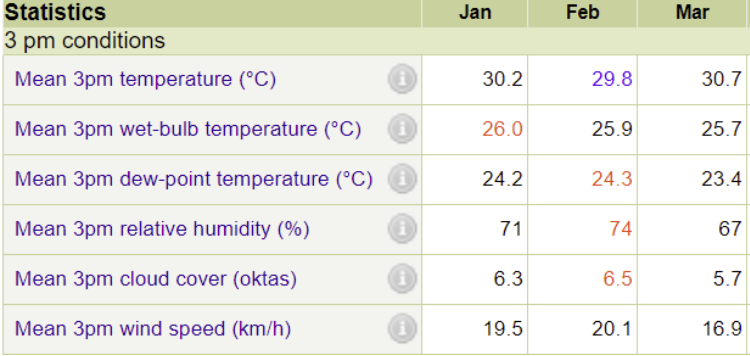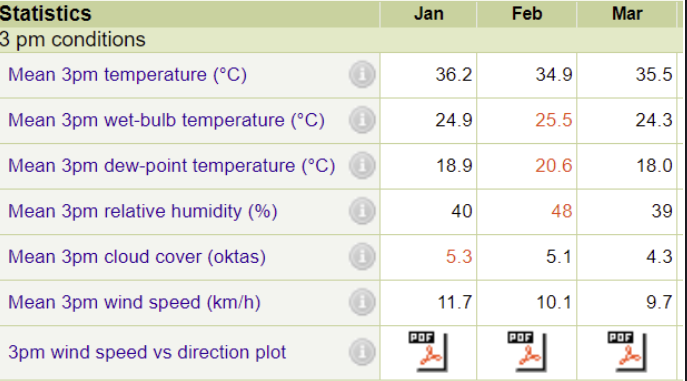|
|
Post by Wildcat on Jan 12, 2021 16:23:35 GMT -5
What’s Central America got to do with the US? Say what you mean. Maybe because Central America, you know…matches the fucking latitude of Fitzroy Crossing?  SE US is even cooler, so really, I'm only doing you a favour. Be grateful 👍🏻 Your statement was “no true heat exists in the US”, which is an attention-seeking generalization. The hottest place in the world is in the US. |
|
|
|
Post by alex992 on Jan 12, 2021 16:24:25 GMT -5
F; horrible climate. Winter lows are nice for the latitude and seems to get good storms, but there's no true break in the heat ever.
|
|
|
|
Post by omegaraptor on Jan 12, 2021 16:27:20 GMT -5
What do you find so wrong about my statement? Tropical latitudes in Central America, indeed, lack any real heat when compared to similar parallels in AU. This place at 19N in Mexico, in the aptly named Tierra Caliente region, is quite comparable to Fitzroy Crossing temperature-wise |
|
|
|
Post by knot on Jan 12, 2021 16:32:25 GMT -5
Your statement was “no true heat exists in the US”, which is an attention-seeking generalization. The hottest place in the world is in the US., what? Not even close. That would be the tropical and equatorial deserts of North-Central Africa. Death Valley is downright cold compared to even the Sahel region, let alone the more arid regions. Leopards really are cooler than Wildcats! FFS. |
|
|
|
Post by omegaraptor on Jan 12, 2021 16:34:15 GMT -5
Maybe because Central America, you know…matches the fucking latitude of Fitzroy Crossing?  SE US is even cooler, so really, I'm only doing you a favour. Be grateful 👍🏻 Your statement was “no true heat exists in the US”, which is an attention-seeking generalization. The hottest place in the world is in the US. Well to be fair the hottest place in the world by average temp is in Ethiopia. Death Valley is simply hottest by record high. |
|
|
|
Post by knot on Jan 12, 2021 16:34:17 GMT -5
I hereby stand, corrected. |
|
|
|
Post by Wildcat on Jan 12, 2021 16:34:59 GMT -5
Your statement was “no true heat exists in the US”, which is an attention-seeking generalization. The hottest place in the world is in the US. Well to be fair the hottest place in the world by average temp is in Ethiopia. Death Valley is simply hottest by record high. True, that’s what I meant. Although Furnace Creek has an average high of 116.5°F in the hottest month vs 116.1°F at Dallol. |
|
|
|
Post by omegaraptor on Jan 12, 2021 16:40:52 GMT -5
Well to be fair the hottest place in the world by average temp is in Ethiopia. Death Valley is simply hottest by record high. True, that’s what I meant. Although Furnace Creek has an average high of 116.5°F in the hottest month vs 116.1°F at Dallol. Despite the Botev period of record, Reggane, Algeria averages 116.4F in July en.m.wikipedia.org/wiki/Reggane#Climate |
|
|
|
Post by Steelernation on Jan 12, 2021 17:23:06 GMT -5
, what? Not even close. That would be the tropical and equatorial deserts of North-Central Africa. Death Valley is downright cold compared to even the Sahel region, let alone the more arid regions. Leopards really are cooler than Wildcats! FFS. So because the southwestern deserts get cooler winters, they don’t get heat? That’s the dumbest thing I’ve heard. Many places in Arizona, Nevada and California have hotter summers than Fitzroy crossing. For 91-20, Death Valley now averages 117.6/88.9 f in July. That’s 47.6/31.6 c, much hotter than anything in Australia. |
|
|
|
Post by knot on Jan 12, 2021 17:26:25 GMT -5
So because the southwestern deserts get cooler winters, they don’t get heat? That’s the dumbest thing I’ve heard. Many places in Arizona, Nevada and California have hotter summers than Fitzroy crossing. For 91-20, Death Valley now averages 117.6/88.9 f in July. That’s 47.6/31.6 c, much hotter than anything in Australia. I obviously mentioned tropical latitudes, no? Also, Death Valley has an extreme geographical setup. Should use windward climates, like Phoenix, instead. |
|
|
|
Post by Wildcat on Jan 12, 2021 17:31:02 GMT -5
I obviously mentioned tropical latitudes, no? Considering you said “the US” and the US has no tropical latitudes, no. |
|
|
|
Post by knot on Jan 12, 2021 17:39:46 GMT -5
Considering you said “the US” and the US has no tropical latitudes, no. Well, Southern FL is a clearly tropical climate, no? And look at how pitiful the "heat" is… |
|
|
|
Post by Steelernation on Jan 12, 2021 21:02:36 GMT -5
I obviously mentioned tropical latitudes, no? Also, Death Valley has an extreme geographical setup. Should use windward climates, like Phoenix, instead. You’re original comment said nowhere in the US and not anything about the tropics. If you are only considering tropics not a fair comparison since the US only has a tiny area of tropical climates. Also that’s a lot of cherry-picking to ignore the rest of the US. Fair enough. Phoenix still has hotter summers than Fitzroy crossing though. |
|
|
|
Post by greysrigging on Jan 14, 2021 3:05:09 GMT -5
Fitzroy Crossing, climatically speaking, peaks for temps prior to the North Australian Moonsoon. The higher latitude definitions of the 4 seasons do not apply at 18*S.
Commencing about mid August most years, the establishment of a heat low over the Kimberley's ( geographically close to Fitzroy Crossing ) is one of the signs of the change of seasons, from the 'Dry' and the cooler south and easterly winds, to the increasing heat and humidity of the 'build up' over northern Australia.
Fitzroy Crossing usually gets its first +38c ( 100f ) in August and first +40c ( 104f ) in Sept. The heat then ramps up somewhat in Oct and Nov, the two hottest months on average. 18*S is too close to the Equator to record massive extremes. Record for Town and Airport are 47.9c and 47.4c ( 118.2f and 117.3f ).
The 'traditional' Southern Hemisphere summer months of Dec, Jan and Feb do record extremes, but on average are cooler than Oct and Nov due to increased cloud during the wet season.
Fitzroy Crossing has recorded +40c ( 104f ) in 9 of the 12 months in a year and +38c ( 100f ) in 10 0f the 12 months. The heat is often relentless, and during the 'wet season', quite debilitating.
|
|
|
|
Post by chesternz on Jan 14, 2021 3:20:05 GMT -5
B+. I'd prefer somewhat cooler highs (3-4 C cooler) in summer and warmer winter lows (5-6 C warmer), but it's not bad. I reckon it's not as bad as it looks as the humidity is mostly pretty low. Compare summer afternoon dewpoints against Darwin, for example: Darwin:  FC:  You can see it's definitely a bit muggy, but significantly less so than Darwin. Plus it's only really muggy for a couple of months. During Nov-Dec when temps are at their peak dewpoints are only around 10-15 C in the afternoon. |
|
|
|
Post by greysrigging on Jan 14, 2021 3:29:52 GMT -5
At their latitude and location in Western Australia, the 'Wet Season' can be a bit 'hit and miss'. The max extremes have been recorded in Dec and Jan, so often its a lottery as to whether you cop a hot and dryish 'wet' or a cooler rainy one. Me ? times I've worked there ? Horrendously hot....haha
|
|
|
|
Post by greysrigging on Jan 14, 2021 3:34:52 GMT -5
|
|
|
|
Post by Ethereal on Mar 14, 2022 17:42:29 GMT -5
D+
The long dry season is tolerable.
|
|
|
|
Post by firebird1988 on Apr 8, 2022 12:11:05 GMT -5
B+
|
|
|
|
Post by Cheeseman on Apr 12, 2022 20:40:34 GMT -5
B. Epic summer heat, including record highs above 110 F six months out of the year. Record lows above 60 F all three summer months. Epic summer storms. Downsides are the hyper-aridity of the dry season and the fact the heat in peak buildup season is a little too intense.
|
|